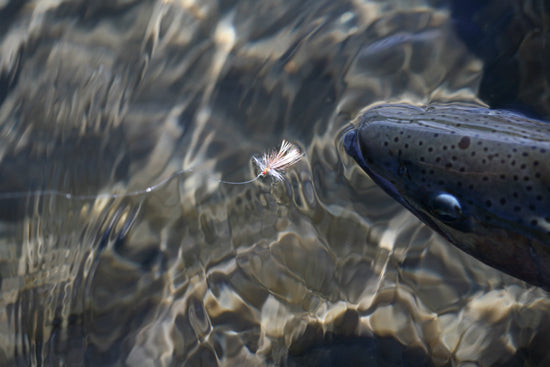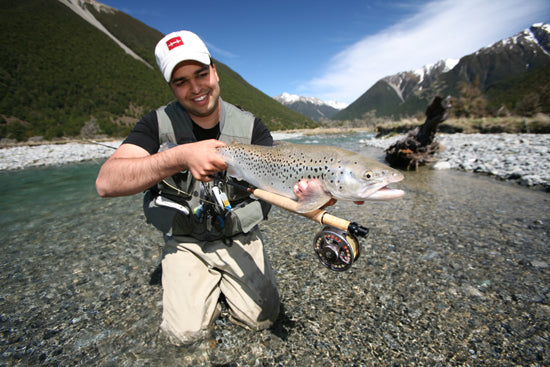Fishing Dry Flies Downstream - Going With The Flow
In New Zealand we’re blessed not only with high quality fishing opportunities but also with a variety of types of fishing. Where we often get it wrong is in adapting to this variety through a range of skills and techniques. It may come as a revelation to some that the techniques they find successful for nymphing for winter spawning run rainbows on the Tongariro are only moderately relevant to what is required on a back country river. In contrast the back country angler may find his honed stalking skills remarkably inefficient when targeting active feeders in some of our lowland rivers.
As the saying goes "if you always do what you’ve always done, you’ll always get what you’ve always got”. The easiest way to change your learning pattern is to start fishing in different areas. Fly fishing different areas is full of many lessons; partly due to the fact that you find yourself faced with the different invertebrate hatches that occur and the vastly different river types that trout inhabit. If that’s not enough to rattle your cage as a 'set in your ways kiwi fly fisher', then when fishing around the globe there is always other fish species to change the way you think about fly fishing. For me, some of these learning curves came from targeting grayling during the spring months on the Welsh River Dee.

Although grayling are well known targets for shortline nymphing techniques they will, during a hatch, readily take a dry. Although I would often find myself casting to a bunch of rising grayling, what I found challenging was to get them to take. At first I blamed the fly, but after working my way through every fly known to man I realized the biggest thing I was struggling with was getting drag free presentations on the small flies needed to catch the grayling. When covering a constant feeder, I would get refusal after refusal until finally the fly came through drag free, then the grayling would fire to the surface and snatch the dead drifting fly. Early on a drag free drift was more of a fluke than anything and after blasting away one in twenty casts would come through drag free. The problem I had was I was used to fishing large deer hair based dry flies back in New Zealand; which due to their larger size weren’t affected by drag like the small flies.

Not happy with my one in twenty cast success rate at getting the right drift, I decided to make some changes. The first was to lengthen my leaders, even to the extent of making sure they were so long that the end of the leader didn’t turn over properly. In casting terms this is crazy but it really helped to create the slack needed. The benefit was the last few feet of the line landed in a heap that resulted in more slack for the drift. The next thing I did was change from my stiff fluorocarbon tippet material to much softer co-polymer tippets, these softer tippets followed the currents and most importantly didn’t sink and pull the fly down with it like a fluorocarbon tippet. The last and most important thing I did was learn to fish my dry flies downstream.

I found that making a presentation downstream had a number of benefits over my normal New Zealand upstream presentations. When presenting the fly downstream the first thing coming into the fish’s field of view is the fly, versus when fishing upstream the fish is first confronted with the fly line then the leader and lastly the fly. Also as the fly enters a slow patch in current the fly line and leader which is in faster water are actually being forced to put more slack in towards the fly. The result is in the slower parts of the current (where the fish are most often rising) you get an easy drag free drift versus with an upstream cast when the fly is sitting in slower water it gets dragged by the fly line which is sitting in the faster current. Lastly when a fish takes a fly presented downstream, the current is not drawing the fly out of the fish’s mouth and consequently, the fish gets a slack leader to engulf the fly on.

Back home as I’ve found myself fishing more and more small dry flies and film flies I’ve found myself being forced into making my presentations downstream to get the right drifts. Unlike fishing the Dee to grayling, with our New Zealand trout you often only get one drift over the fish before it is either caught or spooked. Consequently my old one in twenty success rate at getting a decent drift wasn’t going to cut it when targeting spooky fish here in New Zealand. For me, the discipline in targeting difficult fish is taking the time to get myself into position to make the right cast first time. Being able to make effective presentations downstream or from various angles in a river using a variety of casts is critical for making sure that a difficult fish gets the best presentation you can make first time around. Additionally on many overgrown rivers it is much easier or sometimes the only option to make a down stream presentation into some pools where trees or other obstructions inhibit you from casting upstream.

The two keys to making good presentations is firstly to make an upstream reach mend (ie. if you are on the true right bank, you reach the line to the left and if you are on the true right you reach your line to the right). This reach ensures that the line is not positioned across difficult currents but rather that the fly, leader and line all float downstream on the same current seam. The second key is to make sure you make slack line casts to ensure you have plenty of slack in your line and leader. This can be done either by wiggling the rod tip just before the cast lands on the water or by casting the line slightly higher in the air than normal so the flies parachute down.
To set the hook, the rules are just the same as fishing upstream. Give the fish a chance to turn down on the fly, and in quick water you’ll find you need to strike quickly to set the hook whilst in slower water you’ll find you need to give the fish more time to turn down on the fly.
Once mastered, downstream presentations can be transferred into nymph fishing or fishing a dry and nymph combination. As we all know, benefits of fishing drag free is equally beneficial for fishing subsurface flies. The downside to fishing downstream, in many circumstances is getting yourself into the right position and making the cast without spooking the fish. With that in mind there are many situations where getting the right drift is more important than anything else and in those situations why fight it, as it is far more effective to go with the flow.
